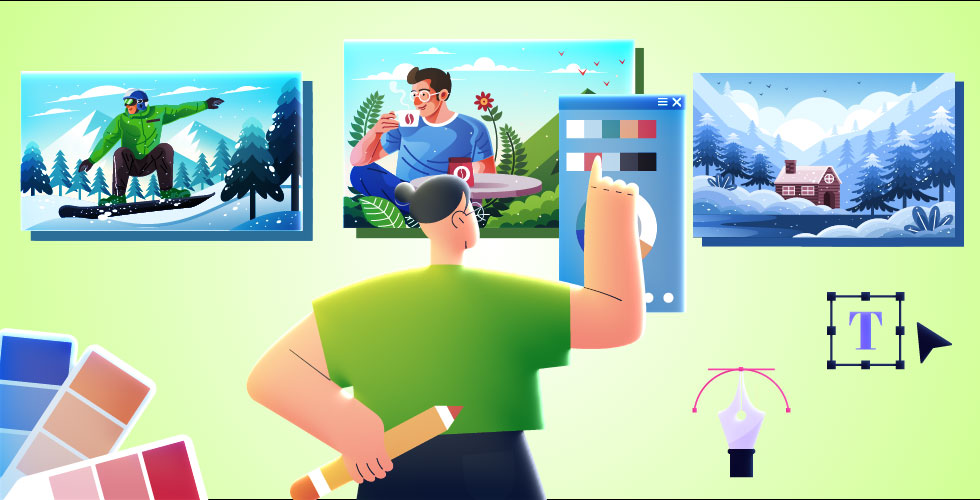If you have ever found yourself captivated by a movie, a video game, or a book, chances are that the narrative design and visual storytelling capture your attention.
These two elements are crucial in any storytelling medium for creating a captivating and immersive experience. They take us to different worlds and allow us to emotionally connect with the characters.
But, what exactly is Narrative Design or Visual Storytelling?
In this blog post, we will discuss narrative design and visual storytelling, exploring their definitions, techniques, and the impact they have on our lives.
What Is Narrative Design?
Narrative design is the art and craft of creating stories for interactive media, such as video games, virtual reality, or augmented reality. It involves shaping the plot, characters, setting, conflict, and resolution of a story, as well as the ways that players can interact with and influence the story.
It’s not the same as writing a script or a novel. It requires a different approach and mindset, as well as a deep understanding of the medium, the audience, and the gameplay.
It also involves collaborating with other disciplines, such as game design, art, sound, and programming, to ensure that the story is integrated with the game’s mechanics, aesthetics, and functionality.
What Is Visual Storytelling?
Visual storytelling is the use of images, videos, animations, or other visual elements to convey a message, a mood, a theme, or a story. It can complement, enhance, or even replace verbal or written storytelling, depending on the context and the purpose.
Visual storytelling can be found in many forms of media, such as movies, comics, graphic novels, advertisements, or social media posts. It can also be used in interactive media, such as video games, to create immersive and memorable experiences for players.
Your Message
With Animation

Transform Your Message With Animation

How Are Narrative Design and Visual Storytelling Used Together?
Narrative design and visual storytelling are closely connected and work together to create immersive and emotionally impactful experiences.
When used effectively, they have the power to transport audiences into new worlds, evoke emotional reactions, and maintain their engagement from beginning to end. Here’s how they work together:
1. Context and Immersion
Narrative design gives context and backstory to guide the visual elements. It introduces characters and sets the stage for the story’s world. Visual storytelling then immerses the audience in this world through visuals.
For instance, in a video game, narrative design may introduce the protagonist and their quest, while visual storytelling showcases the beautiful landscapes and imaginative creatures encountered during the journey and makes dry content captivating.
2. Emotional Engagement
Visual storytelling is a powerful way to evoke emotions. The expressions on characters’ faces, the colors used, and how scenes are framed all play a role in how the audience feels.
On the other hand, narrative design ensures that these emotional cues match the overall story. For example, if the narrative design calls for a sad love story, the visual storytelling will incorporate techniques like gentle lighting and melancholic music to intensify the emotional impact.
3. Player/User Agency
In interactive media like video games, narrative design shapes the story’s choices and branching paths. Visual storytelling adapts to these choices, creating a seamless experience. This dynamic interaction between narrative and visuals makes the player’s decisions feel meaningful and impactful.
4. Pacing and Tension
Both narrative design and visual storytelling collaborate to manage the flow of the experience. They decide when to unveil unexpected turns in the plot, introduce conflicts, and create suspense. By coordinating these elements, creators can keep the audience engaged and eager to see what happens next.
5. For SaaS Marketing
In the business world, SaaS products can be complex and require clear communication. Combining narrative design and visual storytelling in explainer videos can greatly improve their effectiveness.
These elements simplify complicated concepts, help users get started, build trust, strengthen brand identity, and encourage clear calls to action.
Working with a professional studio like 10 Studio can help you create compelling videos to promote your SaaS offering. Their expertise in storytelling can elevate your video marketing, ensuring your message connects with your audience and leads to more customers.
Visual Storytelling Techniques
Visual storytelling relies on several techniques to effectively convey a narrative. Let’s explore some of these techniques:
1. Crafting Meaningful Visual Compositions
Composition is the process of organizing visual elements in a frame to create an image that is visually appealing and meaningful.
This process involves making decisions about how to frame the image, achieving balance, and positioning the subjects within the shot. By employing proper composition techniques, the viewer’s attention can be directed towards important elements of the story and the overall mood can be established.
For instance, in a film, a close-up shot of a character’s face can reveal their emotional state, while a wide shot of a vast landscape can emphasize the grandeur of a setting.
2. Conveying Mood and Theme Through Colors
Color is important for expressing emotions, themes, and atmosphere. Each color can portray certain feelings, and artists use color palettes to set the mood of a scene.
For instance, warm colors such as red and orange can represent passion and energy, while cool colors like blue and green can evoke a sense of calmness or sadness.
3. Setting Tone and Depth with Lighting
Lighting is a powerful tool for setting the tone and highlighting important elements. It can create contrast, shadows, and visual depth.
For example, harsh, directional lighting can create tension and drama, while soft, diffused lighting can impart a sense of serenity. In the horror game “Resident Evil 7,” the use of dim, atmospheric lighting creates a terrifying and suspenseful environment, immersing players in the horror experience.
4. Focus Through Movement and Animation
Visual storytelling commonly uses camera movement, object motion, and character animation to direct the audience’s attention and enhance the narrative.
Camera movements, like tracking shots or pans, can guide viewers to important details, while character animations express emotions and actions.
In an action sequence, fast camera movements and dynamic character animations can convey the excitement and chaos of the scene, while a slow and steady camera pan can be used to reveal a crucial plot element in a more contemplative manner.
5. Shaping Narrative Impact Through Shot Framing
The framing of a shot determines what the viewer sees and doesn’t see. Creators use various framing techniques to emphasize important story elements or create a particular mood.
Close-ups can reveal emotions, while wide shots can establish a sense of place and scale. In the video game “Red Dead Redemption 2,” the wide, expansive framing of the Western landscapes conveys a sense of freedom and adventure.
6. Crafting Engaging Narratives Through Editing
Editing involves the arrangement and sequence of shots to control the flow of the narrative. It dictates the pace, right visual style, transitions, and the juxtaposition of images. Proper editing can build tension, create surprises, and establish rhythm.
Narrative Design Techniques
Narrative design includes various techniques that assist in shaping the story and the world in which it takes place. Here are some of the key Narrative Design techniques:
1. Crafting Compelling and Twisting Plots
The plot is the backbone of the narrative. It outlines the sequence of events, conflicts, and resolutions that make up the story. A well-crafted video script engages the audience by providing a clear structure and a compelling narrative arc.
If you played, “The Witcher 3: Wild Hunt,” you may notice, the intricate and branching plotlines allow players to make choices that significantly impact the narrative’s outcome.
2. Weaving Rich and Distinctive Characters
Characters are the heart of any story. Narrative design involves creating well-developed characters with distinct personalities, motivations, and arcs. These characters drive the plot forward and make the audience care about the outcome.
3. Evoking Atmosphere Through Vivid Settings
The setting is the backdrop against which the narrative unfolds. It includes the time, place, and environment in which the story takes place. The setting can be as essential as a character, shaping the events and influencing the atmosphere.
Like, in the “Star Wars” film series, the diverse and visually captivating settings of different planets contribute to the epic and otherworldly feel of the narrative.
4. Driving Narratives Through Diverse Conflicts
Conflict is an essential part of storytelling. The narrative design incorporates different types of conflict, either internal or external, to advance the plot and present challenges for the characters.
Conflict keeps the audience engaged and invested in the story, which you can find in the video game “The Legend of Zelda: Breath of the Wild”. The conflict between the protagonist, Link, and the formidable Calamity Ganon drives the action and exploration in the vast open world.
5. Concluding Stories with Emotional Fulfillment
The resolution is the conclusion of the narrative, where loose ends are tied up, and the story reaches its climax. A satisfying resolution provides a sense of closure and emotional fulfillment for the audience.
Conclusion
Overall, narrative design and visual storytelling work together to create captivating experiences. Whether in video games, movies, or theme park rides, narrative design provides structure by introducing characters, plot, and emotions.
Visual storytelling, on the other hand, brings the story to life through colors, animations, and lighting, allowing us to empathize with the characters. Together, they engage us in the story and make us part of the adventure.
Your Message
With Animation

Transform Your Message With Animation

As technology advances, these storytelling tools will continue to evolve, offering even more immersive and incredible stories for everyone to enjoy.
So, when you play a game or watch a movie, remember that it is the collaboration between narrative design and visual storytelling that truly makes the experience magical and captivating.






